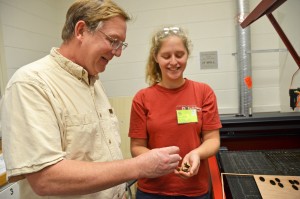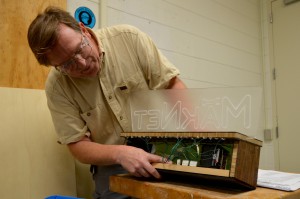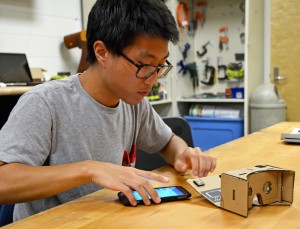Be a maker
December 7, 2015
That’s how Glenn Walters, PhD, director of the Environmental Sciences and Engineering (ESE) Design Center at UNC’s Gillings School of Global Public Health, summarizes the newly opened makerspace, housed on the lower level of UNC’s Hanes Art Center.

Dr. Walters and biomedical engineering student Jewell Brey examine tiles made by the laser cutter. (Photo by Linda Kastleman)
“Perfection doesn’t teach you nearly as much as screwing something up and then fixing it,” he says, as he fits a sheet of acrylic into the workshop’s precision laser cutter.
For more than two years, Walters has taken a leadership role with the Be A Maker (BeAM) initiative on campus. (See uncbeam.org.)
BeAM oversees a growing network of makerspaces, in which UNC students and members of the faculty and staff are given tools and training to turn metal, wood and electronics into solutions for scientific and technical challenges – or into art.
The core philosophy of BeAM’s leadership committee parallels that of “maker culture,” an international movement concerned that hands-on skills are undervalued in today’s digital world. The movement is part of a fast-growing national trend, and some students consider availability of such spaces as a factor in deciding which college to choose.
Walters was invited to join the BeAM committee as an expert adviser for tool and technology selection. He agreed, excited to give students and others an opportunity to build their own creations.
He loves the challenges of his job at the ESE Design Center but says the center mostly serves those who need to have a finished product designed and fabricated to further their research.
“My job there is to take ideas – which often aren’t fully formed – and come up with functional solutions,” Walters explains. “The goal of the makerspaces is for people to be empowered to get hands-on experience and develop solutions for themselves.”
Walters says that having a better grasp of the available tools and processes leads one to think more expansively, which frequently leads to a more elegant and innovative final product.
Staff members at the BeAM Hanes Art Center makerspace offer training ranging from basic safety orientations to the use of what Walters calls the “gateway drugs” of making – a high-tech 3D printer and impressive laser and vinyl cutters.
These tools excite the imagination without taking a long time to master. After completing an initial project – e.g., engraving a wooden keychain – most people feel ready to explore the makerspace more broadly. (A UNC College of Arts and Sciences video of students building an operational telescope during a BeAM workshop series is available online.)
Walters is encouraged by how many people are using the facility. Tours offered in August resulted in more than 160 new names on the BeAM student listserv, which also shares information about the original makerspace in Kenan Science Library (KSL) and the forthcoming facility in Murray Hall.
Students already use the Hanes workshop and the KSL makerspace to print 3D models of architectural designs, create elaborate Halloween masks and craft virtual reality goggles based on Google Cardboard (google.com/get/cardboard). Many of them are members of MakNet, the UNC student organization that promotes maker culture (maknet.web.unc.edu).
Walters hopes their newfound skills will lead to innovation that reaches far beyond the UNC campus.
– Jennie Saia
.
What they’re saying…
“I believe that in the near future, prospective students on UNC campus tours will clamor to see our makerspaces. The BeAM network and the philosophy of innovation behind it are becoming as integral to UNC’s student life and scholarship as are libraries and classrooms.”
– Glenn Walters, PhD
“Glenn [Walters] has been a phenomenal partner and leader in this work because he has such a broad and deep understanding of making. He’s been at the front and center of BeAM’s efforts. His day-to-day work covers an array of projects, from electronics fabrication to traditional machining.
Glenn really engages people who come to him with design problems. He is deeply committed to teaching and training students, and he’s
truly passionate about the wonder and power of making. He wants to engage and empower others with the knowledge that they are makers and can create effective designs themselves.”
– Richard Superfine, PhD
Director, Center for Computer- integrated Systems for Microscopy and Manipulation (cismm.org), which oversees UNC’s BeAM spaces makerspace in Kenan Science Library (KSL) and the forthcoming facility in Murray Hall.
Header photo by Linda Kastleman
Carolina Public Health is a publication of the University of North Carolina at Chapel Hill Gillings School of Global Public Health. To view previous issues, please visit sph.unc.edu/cph.


